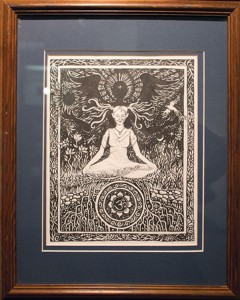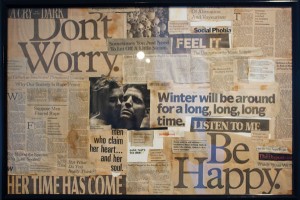
The house was packed with strangers. Shy at the age of 16 and lacking in experience with alcohol, Star Daniels filled her cup with Jim Bean whiskey time and time again. When Daniels stumbled into another room, she found a mattress on the floor.
There, Daniels became a spectacle. She recalls being raped by at least four different men, and remembers others saying they wanted a turn. When the party came to a close, she was left unconscious on the curb outside her house.
At school the following Monday, the perpetrators walked freely through the halls. It wasn’t the first assault that Daniels had kept secret.
“Healing itself is an ongoing process,” she said, now a 39-year-old artist in Ithaca. “I feel that anybody that’s been victimized can always feel it return.”
For the month of April, Daniels’ account of her past and intimate healing process will be illustrated in hundreds of delicate black lines — two pen and ink sketches, hanging on a wall in the Community School of Music and Arts for all to see.
Hanging the collage on the wall there, even though I’m doing it anonymously, is almost like I’m displaying to the world ‘This is what’s inside of me.’ – Karen*
“The Art of Surviving,” an art exhibit created by the Tompkins County Advocacy Center, features artwork created by Daniels and 16 other survivors of sexual abuse, sexual assault and rape. The exhibit is one of many events held by the Advocacy Center in April, which is National Sexual Assault Awareness Month.
In the lobby gallery on opening night last Friday, visitors wandered slowly from piece to piece, pausing to stare at watercolors and photographs, acrylics and embroidery, eyes wide and unflinching.

The exhibit is co-sponsored by the Advocacy Center, an organization that provides supportive services to youth and adult victims and encourages sexual assault awareness and prevention education. Artistic projects are especially used with teenagers, who may not be as comfortable discussing their traumatic experiences.
Heather Campbell, the Advocacy Center’s education director, supervised the creation of the exhibit.
“There’s a lot of value in using art in the healing process,” she said. “It’s a really creative outlet that allows survivors space to sometimes express things that are hard to say in words, that can be expressed differently through a creative process than maybe we even have language for.”
A narrow space between the staircase and the glass wall of the main entrance leads to a poster, plastered in browning newsprint, titled “Echoes of My Life From NYT.”
By rearranging the words of others, in jagged print and picture clippings, Karen* conveys her experience.
At the age of 12, Karen woke up every day with dread, fearing that she would be pregnant before she even had her first period. In high school, she said, she had to fake losing her virginity to her friends to cover her secret: that a member of her own family had taken it from her.
More than a decade later, still in the process of recovery, Karen began to piece together her feelings. A collage began to form.
“When somebody’s hit by a bus, they go to the hospital and people send flowers,” she reflected, now 58 years old. “But nobody sees [abuse], the people who are recovering from the same kind of emotional damage, it’s not physical, but it’s emotional. People don’t want to hear about what you’re recovering from.”
Her carefully constructed collection of headlines, editorials and photographs has been hidden in a black plastic garbage bag since 1991 — until now.
Alison Bliss, an adult sexual assault counselor at the Advocacy Center and creator of the exhibit, hopes the artists’ work will generate conversation.
“Sometimes [people] don’t want to talk about our issues or think it happens in this community,” Bliss said. “It’s a sad reality and truth that violence happens in this community, specifically sexual violence.”
The sensitive nature of the exhibit was a concern for the CSMA, given that the gallery is located in the entrance to the building, frequented daily by children taking music and art lessons. Executive
Director Robin Tropper-Herbel requested that submissions be explicitly monitored in terms of content.
“The subject matter is extremely intense and painful perhaps,” Tropper-Herbel said. “That can be conveyed in many ways artistically, not necessarily manifesting itself in a very graphic manner or violent manner or sexually appropriate manner, which would be inappropriate for young children.”
Bliss said she is thankful: Despite such a sensitive theme, she and Campbell did not need to censor or reject any pieces from being presented in the gallery.
Darren Usinowicz, a local Ithaca resident, was one of many who came to the
exhibit opening.
“To display [the art] in a public setting like this is powerful,” he said. “To say, ‘You know, yeah, this happened to me, but look at what I can do, look at what I am.’”
Sexual Assault Awareness Month, created by the National Sexual Violence

Resource Center in 2001, encourages awareness of sexual abuse. While the art is meant to get people talking about sexual violence, Bliss said several artists will choose to remain anonymous.
Karen is one of them.
“Hanging the collage on the wall there, even though I’m doing it anonymously, is almost like I’m displaying to the world ‘This is what’s inside of me’,” she said.
Amid the smudges of print, her statement is written in bold, black letters on poster board: “You can’t let them scare you into hiding.”
*Name has been changed to protect artist’s identity.




